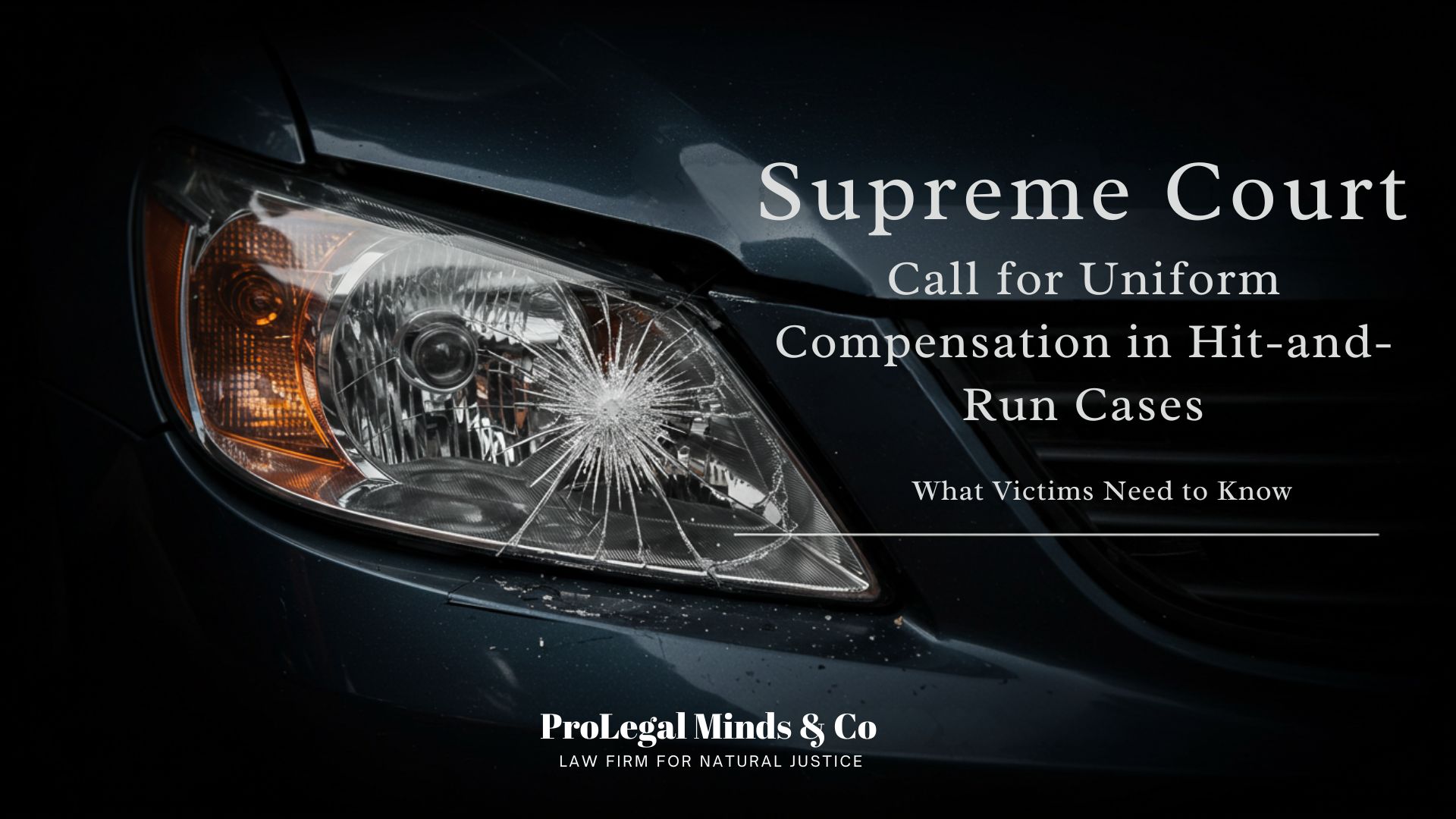SC’s Call for Uniform Compensation in Hit-and-Run Cases: What Victims Need to Know
Introduction
On May 2025, the Supreme Court of India took a significant step toward addressing inconsistencies in compensation awarded to victims of hit-and-run accidents across India. In a landmark directive, the Apex Court called for uniformity in the compensation framework under the Motor Vehicles Act, signaling a shift toward a more equitable and transparent legal standard.
This article explores the legal framework, current issues, Supreme Court’s intervention, and the remedies available for victims and their families.
1. Legal Framework Governing Hit-and-Run Cases in India
1.1 Definition of Hit-and-Run
As per Section 161(1) of the Motor Vehicles Act, 1988 (amended in 2019):
“Hit and run motor accident” means an accident arising out of the use of a motor vehicle the identity whereof cannot be ascertained despite reasonable efforts for the purpose.”
This definition clearly identifies cases where the offending vehicle flees the scene and cannot be traced.
1.2 Section 161: Compensation Scheme for Hit-and-Run Victims
Bare Act Provision:
Section 161(3): “Subject to the provisions of this Act, there shall be paid compensation of a sum of ₹2,00,000 in the case of death and ₹50,000 in the case of grievous hurt to the victim or the legal representatives of the victim of a hit and run motor accident.”
Explanation:
- The Central Government is mandated to create a scheme to ensure compensation.
- The compensation is fixed, irrespective of the victim’s earning capacity or circumstances.
- The scheme is no-fault, meaning victims are not required to prove negligence.
2. Supreme Court’s Concern: Injustice Through Inconsistency
In the recent matter [In Re: Uniform Compensation for Hit-and-Run Cases, 2025], the Supreme Court bench led by CJI D.Y. Chandrachud observed that:
“There exists an unjustifiable disparity in compensation awarded across states and tribunals, leading to unequal treatment of victims based on geography rather than legal rights.”
The Court called for:
- A uniform, centralized framework for compensation.
- Removal of arbitrary differences based on state notifications or discretionary awards.
- Accountability from authorities in implementing timelines and disbursal procedures.
3. Issues with the Current Compensation Model
3.1 Insufficient Compensation
- ₹2 lakh for death and ₹50,000 for injury is grossly inadequate in today’s economy.
- No consideration of loss of earning capacity, dependency, or emotional trauma.
3.2 Delays in Compensation
- Victims face administrative delays in applying and receiving compensation.
- Often, legal heirs are unaware of their rights.
3.3 Lack of Awareness
- Many victims or their families do not claim compensation due to lack of legal knowledge.
- Government’s public information campaigns are inadequate.
4. Related Case Laws & Judicial Observations
4.1 Sarla Verma v. DTC (2009) 6 SCC 121
Though not a hit-and-run case, the Court laid down a structured formula for calculating just compensation under Section 166, which is often cited in accident-related matters.
4.2 K. Suresh v. New India Assurance Co. Ltd. (2012) 12 SCC 274
SC held that tribunals should ensure compensation is just and reasonable, suggesting that nominal amounts may fail the test of Article 21 protection.
4.3 SC Suo Moto Writ (2025)
The Court noted that “Right to life includes the right to dignified compensation in case of wrongful loss of life.”
5. Remedies for Victims and Families
5.1 Claim Compensation under Section 161
- File application with the Claims Enquiry Officer (usually Tehsildar).
- Submit FIR, Postmortem report, and identity proof.
- Application forwarded to District Level Committee.
5.2 File Under Section 166 (if Offender is Known)
Victims may also seek additional or full compensation under:
Section 166, MV Act: “Application for compensation in respect of accidents involving death or bodily injury.”
This allows:
- Claiming higher compensation through Motor Accident Claims Tribunal (MACT).
- Assessment based on earning, dependency, age, etc.
5.3 Filing a Writ for Delay or Denial
- If compensation is unduly delayed or denied, a writ petition under Article 226 of the Constitution can be filed before the High Court.
6. Proposed Reforms & Government Role
- The Standing Committee on Transport (2023) recommended raising compensation to ₹5 lakh for death and ₹1.5 lakh for injury.
- There are proposals to integrate compensation with Ayushman Bharat and E-Shram for direct beneficiary transfer.
- Insurance Regulatory and Development Authority of India (IRDAI) is exploring a centralised accident claims portal.
7. How ProLegalMinds Helps Victims
At ProLegalMinds, we assist families with:
- Filing Section 161 & 166 claims.
- Navigating district-level compensation processes.
- Filing PILs or writs in High Courts in delay cases.
- Securing enhanced compensation through MACT.
Conclusion
The Supreme Court’s proactive step in demanding uniformity in compensation for hit-and-run victims is a constitutional milestone that upholds Article 14 (Right to Equality) and Article 21 (Right to Life).
For families suffering from such tragic incidents, understanding the legal remedies and structured support available under Indian law can make a huge difference in getting timely justice and financial relief.
🔍 Need Legal Help on Motor Accident Cases?
📞 Call: +91-9494051717 📱 WhatsApp: +91-9494051717 🌐 Visit: prolegalminds.com
📅 Book Meeting: Click to Schedule 🔗 LinkedIn: ProLegalMinds

